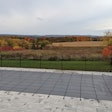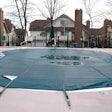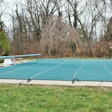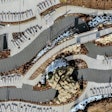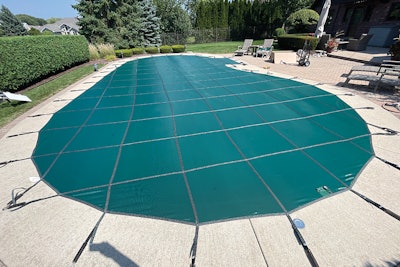
You think you know all about pool covers. After all, it's just a vinyl sheet stretched over the water hole to keep things out. But whether it's automatic, solid or mesh, there's always a new tip or trick when it comes to installation and maintenance. To pick up a few of these, we talked to three pool and spa professionals above the frost line.
The following expertise is all thanks to our panel of industry veterans: Steve Smith with All Seasons Pools & Spas, Maggie Wood with Hansen's Pool and Spa, and Gaelan Seibold with Penguin Pools.

AQUA: LET'S START WITH INSTALLATION. WHAT'S YOUR STANDARD APPROACH?
SS: Installation depends on the pool. If it's a paver deck, we'll start with the copper or a stainless steel tube — whatever comes with the product — and drive that about 15 inches into the ground, every 3 to 5 feet depending on the pool. And the grommet itself then sits inside of that tube you drive into the ground to provide support for the cover.
MW: We typically do concrete pools, so we don't need to use tubes very often, just anchors, but one really important thing when it comes to safety covers is making sure you get the right size for the pool. I've had some customers try to put a bigger cover on a smaller pool — because they got a better price on a stock size cover.
But the problem is that the cover overlap is going to rub on the concrete or whatever it may be, and the manufacturer won't cover that wear under warranty. And so if someone's putting on a cover that's too big for a smaller pool, that's going to rub and wear out much faster, and you won't have a happy customer, which none of us want. So we're super adamant about getting those specs right on the cover to make sure that it's the perfect fit for the pool.
Sometimes we have challenges from decking being 18 inches on one side and 10 feet on the other, so we make sure we get shorter springs for the thin side. We send our technicians to go out and do measurements for customers that don't want to do their own, which happens most of the time, and just to make sure we get the right size for the pool.
We're in the olden days over here, so we don't do the pictures that you send to the manufacturer to size the cover. We do the AB point measuring, where you make 40, 30 to 50 points around the pool, and you take measurements to really get that custom size. Especially if it's like a lagoon shape type pool, you really need to get the measurements exact to make sure it fits. But you can get a safety cover for basically any pool that exists out there.
GS: A majority of our pools just have concrete decking. Occasionally, we'll run into a patio, but installation is pretty much similar between the two, outside of the anchor. The biggest thing is just making sure that your starting point is correct, otherwise everything will end up being off.
It's kind of the biggest thing we tell your techs is to triple check that starting point, that's the point you're going to be measuring off of and making all these changes. So it's kind of a big thing. But we actually started using Latham Measure, which is kind of a laser measuring device, and that's been an absolute game changer for measuring pools and safety covers.
For any kind of water feature, we used to do the old AB method and that would take an hour and a half, maybe two hours. Now, we can be in and out in 15, 20 minutes and just have a design to us within typically 24 hours. So that's made life considerably easier, a lot more efficient, a lot more accurate on our safety cover design and install. And they're working on a unit that measures liners as well.
AQUA: WHAT IS YOUR PROCESS FOR OPENING AND CLOSING?
SS: So yeah, we categorize openings based on what the customer needs. If they have a cover, we will do spring-anchored cover removal with two-man crews to specifically handle that cover, and we do charge a little bit more for a spring-anchored cover or a mesh winter cover opening versus a no-cover opening because of that second man that has to be in the backyard.
We try to do it in a way that the debris on the cover doesn't end up in the pool to save time vacuuming, and we will typically fold it up and if they have a bag there, we'll put it in a storage bag and put it where the customer wants it stored. And we'll recess the grommets so they're flush and not a tripping hazard.
GS: We have essentially the same process. But we actually only do mesh safety covers. If a customer has a solid cover, we will have them remove it mainly because it's very time consuming, and you usually end up with a ton of debris in the pool versus the mesh ones.
A majority of our openings, we also do the closings for, so we'll install the cover again in the fall, and we kind of do it the same way on every single pool so that when we close the pool, all we have to do is just roll it out. It's folded up the same way, and that helps us figure out what corners go where. That makes life easier at the end of the year, just knowing where everything goes every single time.
SS: Just like he said, I think that's a genius move to mark the cover in some way and make notes, especially on a freeform, so the team closing the pool doesn't have to spend an hour wondering which corner is which. That's awesome.
The other part of closing with covers is making sure my guys have extraction kits on their truck. You'll have times where the brass grommets are stuck in the ground or damaged. We charge $25 to remove an old one and replace it, and being able to do it right then and there when you're in the backyard saves the customer a lot of money and us a lot of time.
AQUA: HOW DO YOU GO ABOUT SELLING REPLACEMENT COVERS?
GS: The majority of our sales come from just stuff that we see at the end of the year or at the opening. We see the cover, and it's falling apart. It has become a safety concern, so they replace it. That's really where a majority of our cover sales come from.
Whenever we do a liner replacement for someone that we didn't build, we'll actually just do a measurement for the safety cover, and that way, we have that information on file so we can kind of market to them.
SS: I do take advantage of LOOP-LOC's or Latham's template program, where if a customer has an old cover they have not thrown away, it saves me a lot of time from a service standpoint of not having to measure anything. We can just box it up and send it back to the manufacturer to use as a template. I'm a huge fan of that.
MW: I don't get a ton of people that come in the store and ask for covers. But our salespeople work at actively listening to customers and what they're saying and what their concerns are, and that gives us some opportunities. Especially at the water lab in the store, it's such a great time to talk to customers about what they need because you stand there for two minutes while the disc spins and instead of just staring at each other in awkward silence, you want to make conversation.
It's such a good time to talk to them about how they feel about their pool and make sure they have everything they need and maybe they might say, "I just get so worried about my kids being out there in the winter." And we might respond with, "Oh, what kind of cover do you have on your pool?"
"It's like this tarp thing we put on."
Well, that's such a good moment to talk about the benefits of a safety cover or an automatic pool cover.
Most of our selling for covers comes through our service department. The guys out there putting on a cover in the fall saying like, "Hey, I've noticed some tears on this cover. How old is it? You might want to consider replacement."
Technicians are professionals in what they do, and customers have a lot of respect for those guys or gals in their backyard, so it's a great time for them to recommend a replacement.
AQUA: HOW DO YOU TALK TO CUSTOMERS ABOUT SAFETY AND POOL COVERS?
SS: On the automatic cover side, I would say that most of the automatic covers that we sell are to people who are concerned about safety and the safety of their loved ones. We really reiterate that it's important to keep the auto cover pump on the cover when it's closed because you get a bunch of rain — you could have 4, 6, 12 inches of water on top of that cover, and it's not safe.
So there are still things that the homeowner needs to do to ensure the cover is safe beyond just purchasing a safety cover.
GS: I get a ton of questions on whether they're going to have kids walk over the safety covers in the winter, and it's like, "Yeah, it'll keep 'em from falling in, but you want to keep everybody off of this. It's not a trampoline."
MW: For sure. These safety products are in place to help prevent an accident, but they are not there to completely protect. You still have to do your due diligence, whether you're a parent, grandparent, nanny, babysitter, whatever, to make sure that people are safe around the pool.
As professionals, we still have to be diligent in educating the customer. And it's a delicate balance because I don't want to scare somebody into not having a swimming pool in their backyard because I know how great they are and what memories they can bring.
































